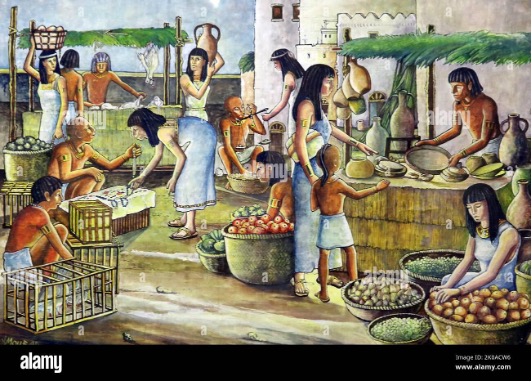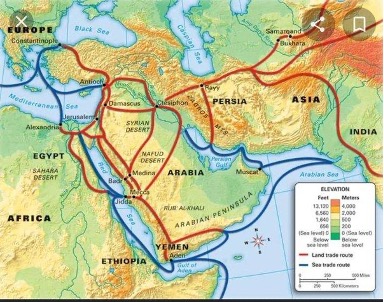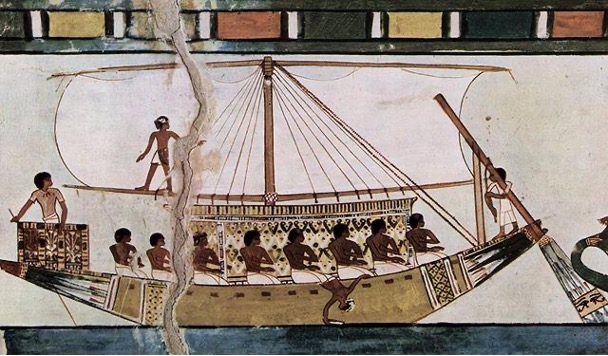Trade has been an exceptionally vital aspect of civilization and humanity as a whole for aeons and aeons. The idea of payment and exchange is an ancient psychology that has been with humanity for extensive periods of time, whether it be through barter systems or through modern ways of electronic banking exchange methods. Trade can be defined in several, boundless ways: physical trade through sea and land routes, exchange through barter systems, electronic trade, etc. Subsequently, one of the most advanced and brilliant civilisations to have ever walked the earth, the Egyptians, were also masters at trading and used several creative routes for trading with other countries. Hence, this article intends to analyse its way of trade, the countries it traded with, and its ways of transportation.

Barter system
The barter system is defined as a way of exchange where instead of physical money or cash, goods and services in requirement are exchanged instead between two or more parties. Egypt began its trading in the predynastic period (6000 – 3150 BC) which continued throughout Roman Egypt (30 BCE – 646 CE) For most of Egyptian history, barter was exceptionally common. They were renowned as very resourceful traders, who would often trade gold, linen, papyrus, and grain for scarce items such as cedar wood, ebony, copper, iron etc.
In terms of social ranking, merchants were considered important and respectable by scribes, and the goods were often brought by merchants, who traded through their shops and various marketplaces.
The Marketplace
Most towns and cities had an outdoor open marketplace where people came to shop and exchange goods everyday. Merchants (then referred to as vendors) would often set up stalls to begin selling their goods. The stalls would be structured in a variety of ways, ranging from directly on a mat to a three sided structure complete with a table. Furthermore, spells on the papyrus were purchased at the spell stall and items such as medicines, amulets, jewellery, perfumes, fruits, vegetables, different kinds of animals (both alive and dead), metal goods, furniture, tools, rugs and salt were all common exchanges. The marketplace also had items which had come for sale from boats that directly arrived from other towns or cities around the Nile that had engaged in trade or exchange with them previously. Traders were well respected and treated on the same social scale as that of merchants.
Aside from the regular way of engaging in direct trade, it was also allowed to use the deben system. A Deben amounted to approximately 3 ounces if measured using today’s weighing system. This is because the Egyptians often utilised the system of metal weights. The item which was purchased would be put on one side of the scale and the debens were placed on the other side until the scales would perfectly balance. Accordingly, it could then be decided that if the trade were to commence, the debens would be collected and used elsewhere in the marketplace.

Countries that Egypt traded with
Due to its geographical setting, Egypt had the advantage of being able to access several routes through the Nile river into the red sea and the mediterranean sea; consequently, enabling extended communication with its neighbouring countries. However, due to having a shortage of resources, they often had to utilize their vast geographical network to engage in barter with other countries. By the first dynasty of Egypt, trade had already flourished with Mesopotamia. The first dynasty of kings had already long ensured a powerful central government at their capital of Memphis, following which, a bureaucracy had developed that handled the administration of the country. This was an early trade partner whose influence on Egyptian art and culture has been observed thoroughly. Around the period of the rule during the first dynasty, Egypt had begun expanding its reach and had initiated international trade with The Levant, Libya, and Nubia. They had established a trading colony in Cannan, Syria, and even more so in Nubia. Amongst the most prominent countries that Egypt had commenced its trading with were Cannan, Lebanon, Nubia, and Punt.
For a long period of time, Egyptians existed alongside Israel and Cannan. Ancient Egyptians in Maadi would practice trade with Cannon by exchanging construction ideas and importing pottery in the fourth Millenium BCE. In addition to this, they also regularly exchanged cultural beliefs and ideologies. Furthermore, Egypt and Cannan also engaged in fish trade around 3500 years ago, by exchanging a fish known as the gilded sea bream.
Egypt also often faced a shortage of high quality wood, due to which they turned to Lebanon, with whom they engaged in trading cedar wood, and communicated with Phoenicians who were Lebanese merchants that lived along the mediterranean. This was essential as they needed to build ships and boats to continue with travelling through water bodies. The Phoenicians would also transport linen and papyrus from Egypt.
In 2300 BC, Nubia was first referred to in old Egyptian accounts as Wawat, Irtjet, and Setju, They were mentioned on account of trade missions and expeditions. Old relations between Nubians and Egyptians depict cultural exchange alongside economic and social cooperation. In terms of trade, they regularly engaged in bartering cattle, gold, ivory, animal skins, vegetable oils, linen and wine.
Lastly, the land of Punt was regarded as an ancient land that was recorded as a massive trading partner of Egypt for a period of at least 1100 years. They primarily imported luxury goods. Namely, incense, leopard skin, living baboons and gold.

Modes of transport used to carry forward trade
When it comes to means of transport that they used to commence trade beyond its border, the use of boats, ships and other vessels that enabled water transport were frequently used to transport goods across different countries and cities. So much so, that they eventually turned into experts in navigating directions across water bodies and constructions of such boats. They began to eventually build a range of boats for different specific purposes such as fishing and going to war.
They learnt how to build small boats using papyrus in around 4000 BC. These were small and fragile boats which were well equipped with oars and poles. Their average boats were small and thin and stuck out at the end. Slowly, they moved to constructing wooden boats using cedar wood imported from Lebanon. Additionally, they began to stick sails in the centre point in order to catch the wind while heading upstream. They were built using wooden planks without nails. Then they began to use cargo ships, which were not only the most historically recognised and glamorised form of sea transport in Egypt, but also the most important and resourceful. They sailed up and down the Nile and the Mediterranean in order to commence trade. Some could also hold up to 500 tons from the quarries to where the pyramids were being constructed. Lastly, they also had funeral boats and boats solely meant for rowing and sailing through the rift waters of the Nile.
Despite water bodies being the main routes of transport, the Egyptians also referred to other means such as extensively travelling on foot, chariots, and animals such as donkeys and camels.
Amongst animals, Egyptians enjoyed using horses the most, donkeys were used for carrying extremely heavy loads, to the point where the temple of Amen itself held 11 million donkeys for use. Other animals used for carrying across heavy burdens eventually came to be camels, who were introduced into Egypt by the Persian invaders.
To conclude, the Egyptians can be looked at as an exceptionally intelligent and resourceful civilisation as a whole. Not only were they plagued with an extreme abundance of resources but they also had several extremely intelligent ways of travelling and exchanging their goods. Furthermore, they were also well connected with many countries and had several geographical routes that enabled them to access different pathways to navigate. They were masterminds in every respective field that required even a little bit of thinking outside of the box and strategy, whether it be trade or otherwise.
Written by – Aditi Singh
Edited by – Aryaa Dubey
